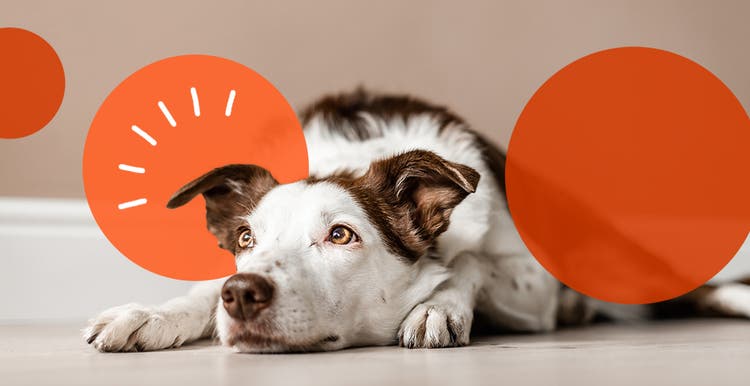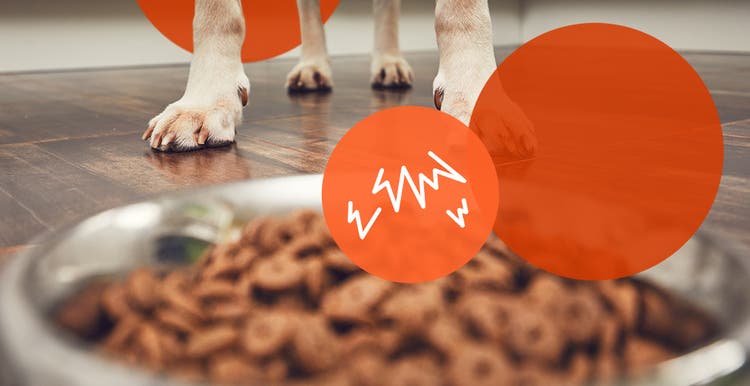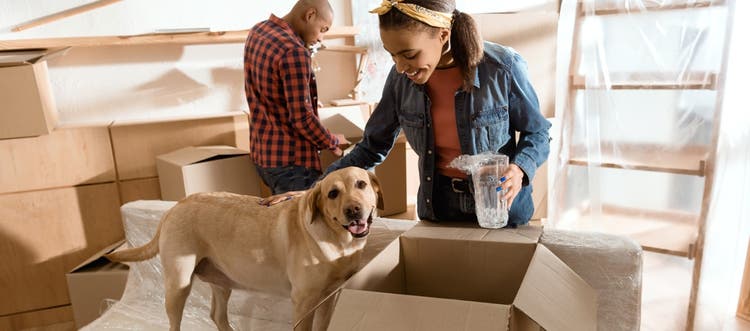Help your dog cope when you’re away.
One of the many great things about owning a dog is their unconditional love for you. But while it’s heartwarming to come home to a pet who is excited to see you, discovering scratched walls, torn couches and chewed-up pillows upon your return isn’t quite as pleasant. The root of these kinds of behaviors may lie in dog separation anxiety.
Signs of Separation Anxiety in Dogs
What causes separation anxiety in dogs? Separation anxiety is triggered in dogs when their owners leave them alone. Symptoms often begin as soon as nervous dogs realize their owners are preparing to exit, and may escalate once they find themselves alone. Signs of dog separation anxiety include:
- Barking, whining and howling. Your dog may start vocalizing as soon as they see you gathering your keys and putting on your shoes — and it will likely get worse once you leave. While you won’t be around to hear their unhappiness, if your neighbors are home, you’ll probably find out about it pretty quickly.
- Destruction of the home. Scratched walls and chewed household objects are some of the most obvious ways your dog is telling you they’re not happy you’ve left the house. This is problematic not only because you’ll need to replace items or repair the damage, but also because your pup could suffer from injuries like broken teeth and damaged nails.
- Urinating and defecating. If your dog is usually housetrained but soils the house while you’re gone, separation anxiety may be to blame — especially if your dog is otherwise physically healthy.
- Escaping. You can often tell if your dog tried to escape (even if they didn’t succeed) by examining them for broken teeth, scraped paws and damaged nails. Windows and doors will likely have scratches and chew marks as well.
- Pacing obsessively. Unfortunately, this isn’t always an obvious symptom, as many dogs won’t start pacing until after their owner leaves. Some may walk in circles, while others may pace back and forth in straight lines.
If your dog exhibits signs of anxiety when you’re at home, their anxiety may be triggered by something else. Read our guide to learn about other causes of dog anxiety.
How to Deal with Separation Anxiety in Dogs
We all want our dogs to be as healthy as possible, and it can cause us stress if we feel like we can’t help ease their anxiety. Fortunately, there are steps you can take to help your dog’s separation anxiety.
Incorporate More Exercise
Take your dog for more walks and play with them regularly. Not only is this bonding time an opportunity to show your pet affection, but it can also help wear them out so they are tired and happy when you leave.
Don’t Make a Show of Leaving or Returning
This can be tough because you always want your dog to feel loved and missed, and you may love to enthusiastically greet your dog when you get home. But from your dog’s point of view, making every hello and goodbye a big deal makes it that much harder for your pet to see you come and go. This doesn’t mean you should ignore your dog. Instead, try to be calm during these moments; you can bring back the petting and excitement after 10 minutes, once your dog knows you're home.
Even if your dog continues to show too much excitement when you walk in, commit to walking in and out in a calm manner. Keep it casual, paying them little attention for a bit before you leave. Do the same when you return, and then give them a calm greeting after a few minutes. You can also perform departure cues, such as jiggling your keys, without actually leaving to show your dog the anxiety-triggering noise or behavior is not always associated with you leaving.
Create a Going-away Toy or Treat
If your dog is suffering from separation anxiety or loneliness, bring home a new toy you know your pet will love. Ideally, the toy should be durable and able to have food placed inside of it. Give the toy to your dog only when you leave; giving your dog a task or some mental stimulation before you leave the house can be a good way to distract them from the unpleasant experience of being alone. Then, when you get home, hide the toy out of reach. Over time, this toy will become the “alone toy” your dog can use to cope with their anxious feelings and help change the negative association of you leaving into a more positive one.
Prepare a Safe Space
Limiting your pup’s movement to a designated safe space may help ease their anxiety. If you’ve crate trained your dog, they likely already associate their crate with safety and security. However, if your dog begins to associate their crate with stress and anxiety, consider confining your pup to one room with a baby gate in your absence. Leave items with your scent, like dirty laundry or blankets, which may send a calming cue, as well as toys to keep them busy.
Untrain the Triggers
Your dog is very perceptive. When you grab your keys or put on your coat, dogs know this means they’re about to go on a walk (fun) or be left alone for a while (not fun). Not knowing which it will be can cause uncertainty and lead to anxiety. Taking the power out of these cues can lessen your dog’s anxious triggers, so you can eventually slip out less noticeably.
Train your pup by going through your normal preparations for leaving (such as grabbing your purse, getting your keys, putting on a hat, etc.) and then not leaving. Continue until your dog becomes more relaxed. Then, try going into the next room for a few minutes and repeat, going for a little longer each time. Once you reach 10 minutes, slip out a different door than normal, leaving your home for 15 minutes; this can be tough with apartments, but still try to leave. Aim to leave for longer amounts of time, every time. Over the course of a few weeks, you should start to see lasting effects that help your dog get through the day with less and less anxiety.
Consider Health Supplements
Stress can often throw off a dog’s digestive health and microbial balance. Giving your dog a probiotic can help maintain their GI health during anxious situations.
Discuss Anxiety Medications with Your Vet
Just like people, dogs can also benefit from anxiety medication. Talk with your vet about finding the proper prescription or over-the-counter option for your pet.
How Serious Is Dog Separation Anxiety?
Like any other disorder, the intensity of dog separation anxiety can vary. Talk to your vet about your nervous dog’s symptoms to determine the seriousness of the condition and whether there could be an underlying medical cause for some of the behaviors. Questions to discuss with your veterinarian include:
- What is your dog’s history? If your dog was abandoned or homeless prior to adoption, then they may fear losing their guardian again.
- Is this a new condition? If so, what may have triggered it? If your dog has never shown symptoms of anxiety in the past, then a specific situation, such as moving or a new schedule, could be causing it. As dogs age and their hearing or vision starts to decline, they also may exhibit different or nervous behaviors.
- Does your dog have other health problems? If so, what role do these illnesses play? Stress can worsen certain health conditions and vice versa, so it’s important to understand your pet’s overall health.
Remember that anxiety is a medical condition and disciplining or scolding your pup for these behaviors will not improve them. But with love, persistence and your vet’s input, you can help ease your dog’s separation anxiety.










